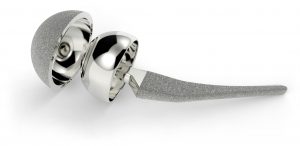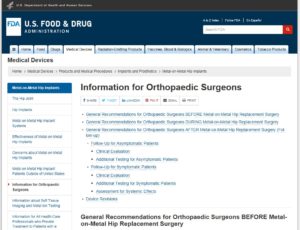Netflix “The Bleeding Edge” documentary tells one victim’s story on Toxic Metal Hip Replacements
August 10, 2018 – San Diego, CA. Meet Doctor Stephen Tower. Doctor Tower is a leading orthopedic surgeon based in Anchorage, Alaska. After receiving his medical degree from University of Washington School of Medicine he located to Anchorage Alaska and began his practice, which has now had for more than 20 years.

Hip Replacement Surgeon – Talks about metal hip poisoning.
Dr. Tower has practiced orthopedic surgery in Anchorage since 1992 and is an Affiliate Professor of Medicine at the University of Alaska. He enjoys an academic collaboration with Dartmouth Biomedical Engineering Center on research to understand the reasons why hip replacements fail. He is a member of the American Academy of Orthopaedic Surgeons and a board member of Health Watch USA.
Needless to say he’s an expert in his chosen line of work, and has performed many hip implants over the years. The following is from his website and used with his permission.
Dr. Tower first observed a hip replacement as a first year medical student in 1979. When he turned to share his enthusiasm with a classmate, he found that the classmate was on the floor. At that point, Dr. Tower felt destined to be a joint replacement surgeon. Dr. Tower served as an assistant surgeon in orthopedics for the Indian Health Service from 1983 through 1986, at which time he began his orthopedic residency at the Oregon Health Sciences University.
In Portland, Dr. Tower researched the difficult problems that are occasionally encountered after hip or knee replacement. This work won the Alonzo Nuffield Award for the best submitted research paper to the 1992 annual meeting of the Western Orthopedic Association and was published soon thereafter.
Dr. Tower returned to Anchorage in 1992. Joint replacement had been commonly performed in Alaska for a decade and some of these joints had worn out and were requiring revision surgery. Revision joint replacement is often more involved than a primary, first-time replacement operation. Few surgeons in Alaska at that time had either the training or the interest to take on these complex procedures. Dr. Tower was willing and was well trained to tackle these challenging cases.
In private practice, Dr. Tower continued joint replacement quality improvement and research through a collaboration with the Dartmouth Biomedical Engineering Center (DBEC). When he revises a joint replacement, the failed parts are sent to DBEC, with the patient’s permission, to determine whether the implant materials or design contributed to the failure of the joint.
We learned of Doctor Tower from the new Netflix original documentary entitled “The Bleeding Edge” available here: https://www.netflix.com/title/80170862
First to find defective parts in common hip implants.
Dr. Tower’s efforts in this regard have identified a major problem with the plastic hip socket liners used in most hip replacements over the past decade. Dr. Tower and DBEC were the first to recognize that if a plastic socket liner is made too thin in order to accommodate a larger diameter femoral head, then the insert might crack, causing the hip to fail within several years rather than within several decades. This work prompted an industry-wide redesign of hip socket liners.
Now focused on analyzing problems with Metal-on-Metal Hip Implants.
More recently, Dr. Tower and DBEC were the first to recognize that excessive wear of metal-on-metal hips (a chrome-cobalt ball rubbing on a chrome-cobalt socket) could not only result in failure of the replacement because of damage to the tissues about the hip, but they also might result in cobalt poisoning (cobaltism). This finding contributed to the removal from the market of almost all metal-on-metal hip designs and to the formal recall of Johnson & Johnson’s ASR hip. This work has also helped develop protocols for monitoring the numerous Americans that were implanted with metal-on-metal hips.
Presently, Dr. Tower and DBEC are studying why corrosion of chrome-cobalt alloy hip implants occurs and how often this leads to hip tissue damage or to cobalt poisoning/cobaltism. A large number of the hips implanted in the United States over the past 20 years have utilized chrome-cobalt parts. There are a large number of Americans who presently may be at risk for corrosion of their chrome-cobalt hip implants.
He undergoes his own Metal-on-Metal Hip replacement surgery.
We again have used his website with permission for the following story of his own problems with metal-on-metal hip implants.
“When I elected to have my hip replaced in 2006, I had twenty years of experience scrubbing in on that operation. I also had contributed to improving hip implant design and to optimizing the treatment of femur fractures that can complicate hip or knee replacement.
I had followed the same advice that I give my younger patients about the timing of joint replacement. For a decade I had been modifying my fitness activities until cycling was the only means I had to maintain my fitness. Once that activity became limited to a 6-mile commute home from the hospital, I signed up for the operation that I knew best and most enjoyed performing.
My rationale for selecting my particular implant seemed sound, particularly in light of my research on the shortcomings of thin plastic hip socket liners. Despite an academic interest in hip implant materials and design and 14 years of experience replacing hips in private practice, I was unaware that my particular implant, like most hip implants available in the United States, had only a cursory pre-market review by the FDA. (Learn about the current metal-on-metal hip lawsuits here.)
My accelerated return to endurance cycling competition reinforced my impression that I had made an optimal selection. My own experience led me to choose an implant with flawed technology into some (fortunately only 6) of my younger, more active patients.
Over 42 months, my replaced hip became painful to the point that I was again limited to a 6-mile bike ride. More concerning, I had also developed sleep disturbance, mood instability, imbalance, tinnitus (ringing in the ears), retinopathy, and stiffening of the heart (diastolic cardiomyopathy).
When my hip was finally revised, a crankcase of metallic sludge was found which had irreparably damaged the ligaments about the hip that provide stability. This deficiency resulted in 10 dislocations of the revised hip. Thankfully, the pain at the hip largely resolved, as did my cardiomyopathy, disordered mood sleep disturbance, hearing issues, imbalance, and vision issues.
Before the revision operation, the cobalt concentration in my blood was found to be 120 times that which is thought to be safe for cobalt-exposed workers and my cerebrospinal fluid (CSF) cobalt level became the third highest reported in the literature at that time.
The publication of my experience, combined with that of one of my patients, was the first time that systemic cobalt poisoning/cobaltism was noted as a potential complication of metal-on-metal hip replacement.
This was initially felt to be an extraordinarily rare occurrence. Over time, additional cases were reported and cobaltism became noted to be one of the complications of metal-on-metal hip replacement, which led to its commercial demise. Additionally, it led to the concept that patients implanted with metal-on-metal hips ought to be monitored for systemic cobalt poisoning/cobaltism in addition to being screened for damage to the tissues around the hip implant.
Of all of the metal-on-metal hips implanted, only 93,000 were formally recalled, leading to concern that numerous patients might be at risk for developing cobaltism/systemic cobalt poisoning.”
All of this is why we are informing people of the very real potential of health problems associated with metal-on-metal hip implants.
Examples of hip replacement manufacturers that have been involved in these metal hip legal cases include:
- Stryker Orthopaedics – Stryker LFIT V40
- Wright Medical Technology – PROFEMUR model
- Smith and Nephew – Birmingham Hip Resurfacing System
- DePuy – ASR acetabular system (Recalled)
- Biomet – M2a Magnum hip implant
- Sulzer Orthopedics (no longer sold)
Current hip replacement lawsuits are active and ready to settle.
Regardless of the brand of hip replacement, if you’ve had a metal hip and had any problems you must act now in order to get your claim started. Even if you don’t know the brand of the metal hip, we can find out for you. Call us directly at 1-800-214-1010 or use the contact form on this page. Again there may be large cash settlements from these defective metal hips, but time to file is close to ending. Use the contact form on this page to begin the claims process.
Sources:
Tower Orthopedic and Joint Replacement https://www.tjrclinic.com/dr-tower-bio
MoM Hips, Dr Stephen Tower Presentation https://earlsview.com/
Note: The information provided in this article is based on reports from publicly available sources, including news outlets, police reports, and eyewitness accounts. National Injury Help has not independently verified all details of the reported incident. If you find any inaccurate or outdated information, please contact us, and we will review and update the content as appropriate. The photo used in this post is for illustrative purposes only and does not depict the actual scene of the incident.
Disclaimer: The content of this article is intended for informational purposes only and does not constitute legal advice or establish an attorney-client relationship with National Injury Help. For legal assistance specific to your case, we encourage you to contact a qualified attorney.
Free Case Evaluation
Contact Us today for a FREE, Immediate Case Evaluation
Contact Us today for a FREE, Immediate Case Evaluation
Categories
Recent post
- Mesa, AZ – Jeep Overturns in Two-Vehicle Crash on Greenfield Rd
- Tempe, AZ – Injury Crash on I-10 EB at US 60 Transition Ramp
- Youngtown, AZ – Two Pedestrians Hurt in Hit-and-Run on Grand Ave
- Phoenix, AZ – Roberto Olivas muere en choque a alta velocidad en Van Buren St
- Phoenix, AZ – Brittany Geib y su perro mueren en accidente seguido de fuga en 51st Ave







